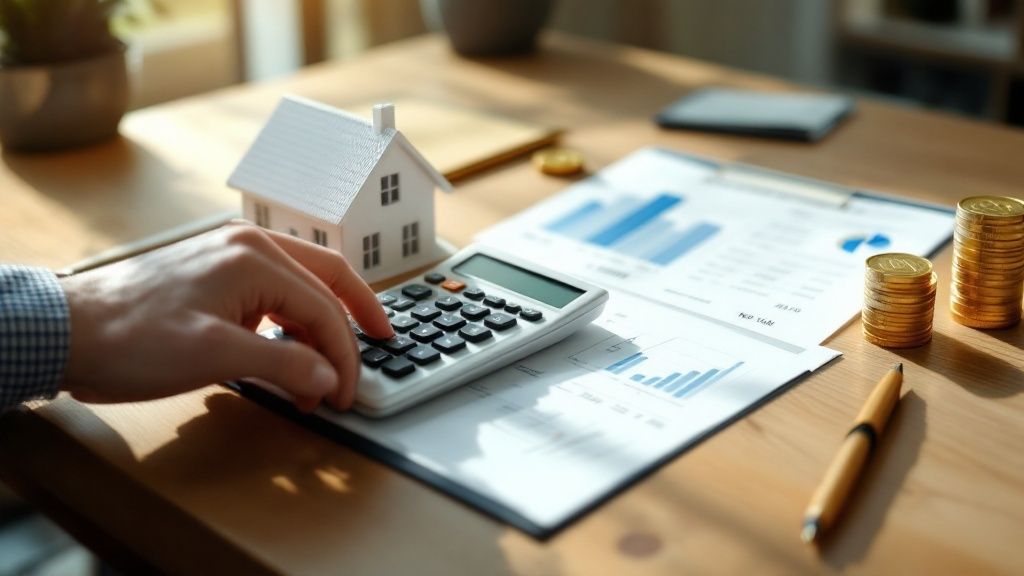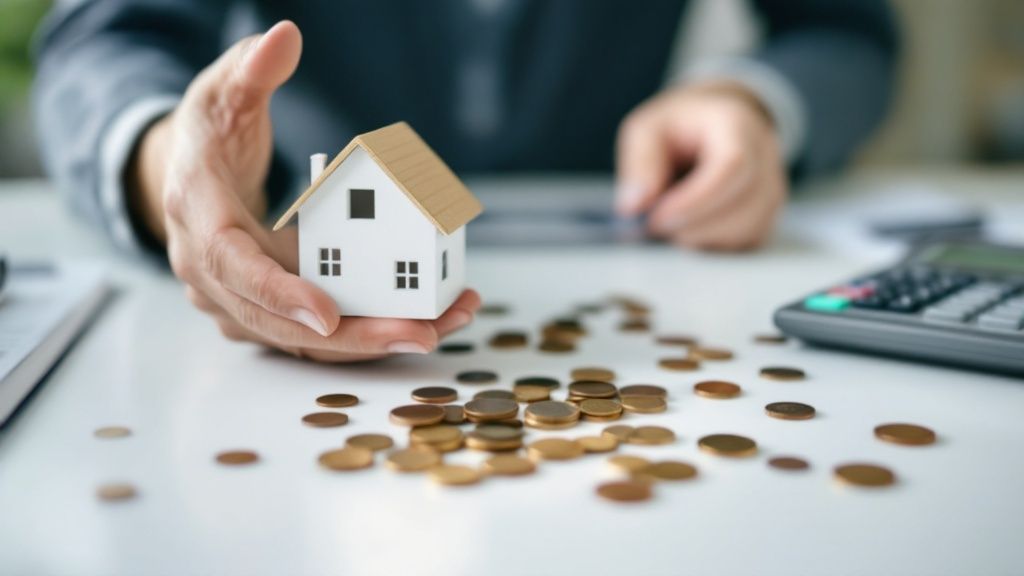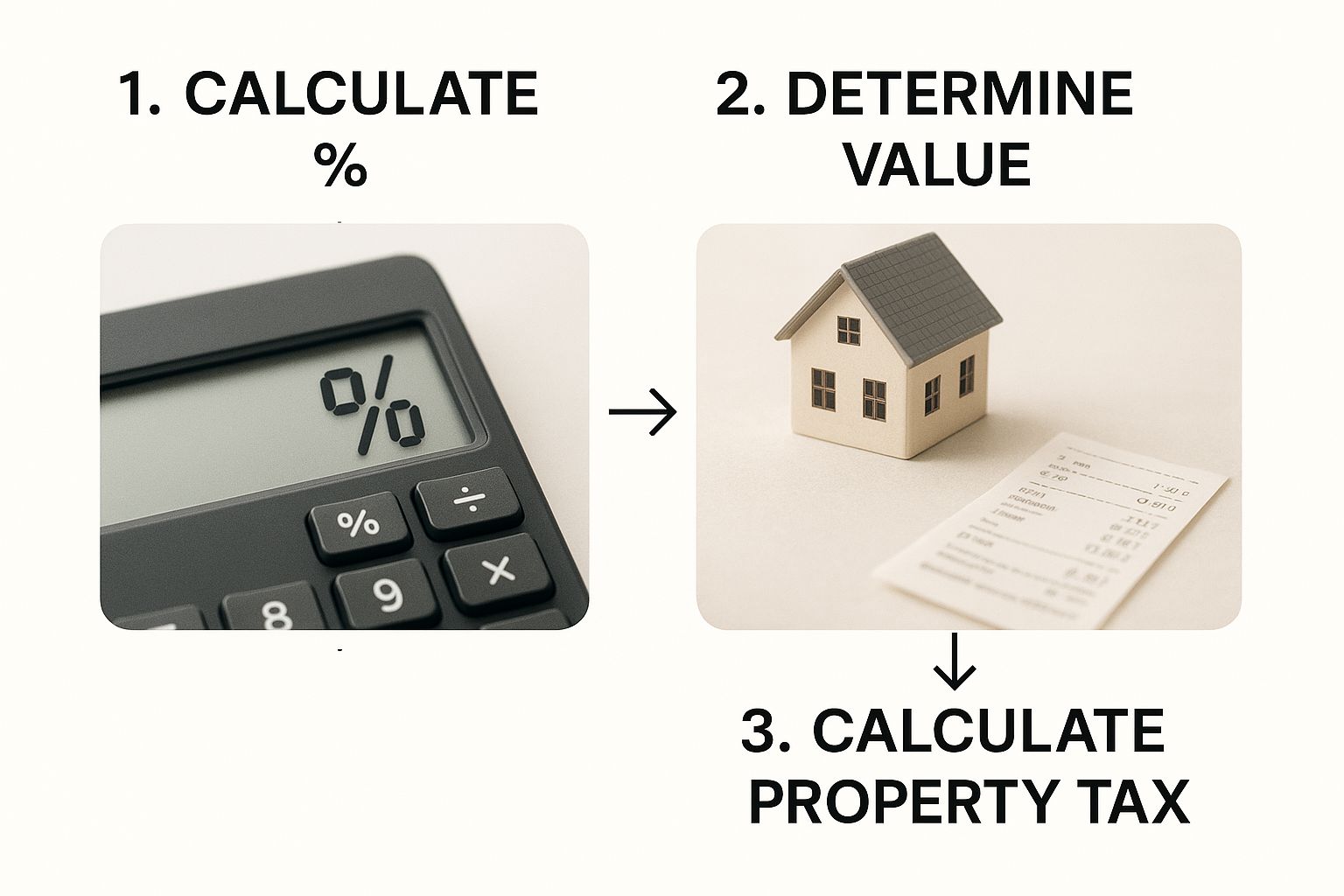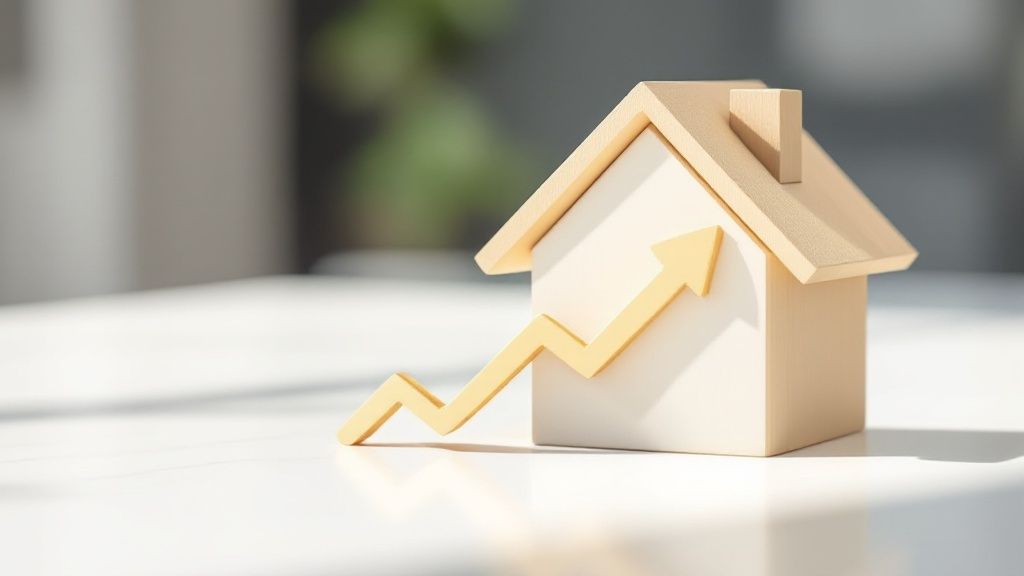How to Calculate Rental Yield Like a Pro

At its most basic, the rental yield formula is straightforward: divide your annual rental income by the total cost of the property, then multiply by 100 to get a percentage. This simple number is your first, most crucial indicator of how an investment property is performing.
What Rental Yield Actually Tells You
Before you get lost in spreadsheets, let's talk about why this one percentage is so important. Think of rental yield as a quick financial health check for your property. It’s the metric you’ll use to instantly gauge how much income a property can generate relative to what you paid for it.
For seasoned investors, this isn't just a formula; it's a fundamental tool for making smart, data-backed decisions. Real estate professionals across the globe rely on it to measure a rental's profitability.
This powerful little number helps you do a few key things:
- Compare Apples to Oranges: It lets you objectively stack up completely different properties. Is that modern villa in Spain a better income generator than the cozy country house in France? The yield will give you a clear answer.
- Track Your Performance: You can monitor how your investment is doing year-over-year. As rents and property values change, so will your yield.
- Spot Good (and Bad) Deals: A surprisingly high yield might point to an undervalued gem. On the flip side, a low yield could be a red flag, signaling it’s time to rethink your strategy or walk away.
At its core, rental yield cuts through the noise. It answers the one question every investor has: "How hard is my money working for me?" This clarity is absolutely essential, whether you're buying your first vacation home or managing a growing portfolio.
Ultimately, understanding rental yield is what separates amateurs from pros. It pushes you past gut feelings and equips you to analyze properties with a sharp, critical eye. It's the first data point you need before you can really dig into the nitty-gritty of net returns and long-term growth.
Calculating Your Gross Rental Yield

Let's start with the basics: the gross rental yield. I like to think of this as the "back of the napkin" calculation. It’s a quick, high-level look at a property's earning potential before you factor in any of the day-to-day running costs. It’s perfect for when you're first scanning listings and need a fast way to see if a property is even worth a deeper look.
First up, you need to figure out your annual rental income. If it's a property you already own, just multiply your monthly rent by 12. If you're evaluating a new purchase, you'll have to do a bit of homework. Look at what similar properties in the area are renting for to come up with a realistic monthly rent estimate.
Don't Forget the Total Property Cost
This is a rookie mistake I see all the time. Your investment isn't just the sticker price on the property. To get a real sense of your yield, you absolutely must include all the other upfront costs you paid to get the keys and make the place tenant-ready.
What does that include? It’s more than you think:
- Closing Costs: These can be a real surprise if you're not prepared. Expect them to be anywhere from 2% to 5% of the purchase price, covering all sorts of administrative and legal fees.
- Legal Fees: You'll need a solicitor or lawyer to handle the contracts and make sure everything is above board.
- Initial Renovations: Did you have to replace the carpets, slap on a fresh coat of paint, or fix a leaky faucet before you could list it for rent? That all goes into your initial investment cost.
If you skip these numbers, you'll get a rosy, inflated yield that doesn't reflect reality. That's a dangerous way to start an investment.
Gross Rental Yield Formula: (Annual Rental Income / Total Property Cost) x 100 = Gross Yield %
Putting It All Together: An Example
Let's walk through a real-world scenario. Say you've found a great little house listed for €300,000. Based on your research, you're confident you can get €1,800 per month in rent.
That gives you an annual rental income of €1,800 x 12 = €21,600. Easy enough.
Now, for the total cost. The purchase price is €300,000. Let’s say your closing costs and legal fees come out to €10,000. On top of that, you decide to spend €15,000 on new flooring and a quick kitchen refresh to attract a great tenant. So, your true initial investment is €300,000 + €10,000 + €15,000 = €325,000.
Now, we plug it into the formula: (€21,600 / €325,000) x 100 = 6.65%
The gross rental yield for this property is 6.65%. It's not your final profit, but it's an essential starting point for comparing this property against others on your shortlist.
Finding Your True Profitability with Net Rental Yield
Gross yield is a great starting point, a quick back-of-the-napkin calculation. But if you want to know how an investment is really performing, you need to look at the net rental yield. This is where the rubber meets the road. It’s the number that reveals your actual profit after all the unavoidable costs of owning a rental property are factored in.
Think of it this way: gross income is what you collect, but net yield is what you keep.

As you can see, a lot happens between collecting the rent and pocketing the profit. Overlooking these expenses is why some investors are surprised when their bank account doesn't reflect their initial high-yield projections. Don't let that be you.
A high gross yield can look fantastic on paper, but it often paints an overly optimistic picture. The real story unfolds when you start subtracting the costs of property ownership, which can be substantial. For an accurate financial picture, you have to get granular with your expenses.
Accounting For Every Operating Expense
To get to your net yield, the first step is to add up every single one of your annual operating costs. These are all the recurring expenses necessary to maintain the property, keep it occupied, and stay compliant.
It’s crucial to be thorough here. Even small, forgotten costs add up and can skew your numbers over the course of a year. Below are some of the most common expenses you’ll need to track.
| Expense Category | Description | Typical Cost Estimate |
|---|---|---|
| Property Taxes | An unavoidable annual tax levied by local governments. Varies significantly by location. | Can range from 0.5% to over 2% of the property's assessed value annually. |
| Landlord Insurance | Protects your investment against damage, liability, and sometimes loss of rent. | Usually 15-25% more than standard homeowner's insurance. |
| Maintenance & Repairs | From leaky faucets to appliance replacements. A "rainy day" fund is non-negotiable. | Budget 1-2% of the property’s value per year. |
| Vacancy Costs | The income lost during periods when the property is empty between tenants. | A conservative estimate is 5-10% of the annual rent (roughly 1 month). |
| Utilities | Any utilities you cover as the landlord (e.g., water, garbage, HOA fees). | Highly variable based on property type and local costs. |
This table isn't exhaustive—you might also have costs for pest control, landscaping, or specific licensing—but it covers the major expenses that will impact your bottom line.
The Impact Of Property Management
Another significant expense to consider is property management. If you decide to hire a professional to handle the day-to-day work—like finding tenants, collecting rent, and coordinating repairs—their fee will directly impact your net yield.
Typically, management companies charge between 8% and 12% of the monthly rental income. While it’s a hefty chunk of your revenue, the service can be invaluable, saving you time and headaches. This is especially true if you're investing from a distance or managing a portfolio of vacation homes. You can learn more by reading our guide on property management for vacation homes.
The Net Rental Yield Formula
[(Annual Rental Income - Annual Operating Expenses) / Total Property Cost] x 100 = Net Yield %
Let's circle back to our example: the €325,000 property bringing in €21,600 in annual rent. Now, let’s inject a dose of reality by adding some annual expenses:
- Property Taxes: €2,500
- Insurance: €800
- Maintenance Fund (at 1%): €3,250
- Vacancy (at 5%): €1,080
- Management Fee (at 8%): €1,728
When you add all that up, your total annual operating expenses come to €9,358.
Now, let's plug those numbers into the formula:
[(€21,600 - €9,358) / €325,000] x 100 = 3.77%
Just like that, the attractive 6.65% gross yield has been whittled down to a far more realistic 3.77% net yield. This is the number that truly matters. It’s the figure you can use to confidently compare different investment opportunities and make informed financial decisions.
So, What's a Good Rental Yield, Really?
You’ve run the numbers and now you have a percentage. Is it good? Is it bad? The honest answer is: it depends. There’s no magic number that works everywhere. What’s considered a fantastic yield in one city could be a total dud in another.
A 3% yield might sound low, but in a prime, stable market like London, that's actually quite strong. Investors there are often playing the long game, betting on massive capital appreciation down the road.
On the flip side, you might see a juicy 10% yield in an up-and-coming market. That higher number is often necessary to make up for bigger risks, like economic volatility or slower long-term growth. It all comes back to context and, most importantly, your personal investment goals.
Cash Flow or Capital Growth? Pick Your Priority
What are you really after? Monthly income to cover your bills, or a big payday when you sell in ten years? This is the fundamental question that determines what a "good" yield means for you.
-
Chasing Cash Flow: If you want a property that puts money in your pocket every single month, you need to focus on a higher net rental yield. This is all about immediate, consistent income after every last expense is paid.
-
Playing the Long Game: If you’re more interested in the property’s value skyrocketing over time, you can afford to accept a lower yield. The real prize here is the profit you’ll make from selling the asset for a hefty sum later on.
The perfect investment strikes a balance between both, but let's be realistic—most properties lean one way or the other. Figure out if you're prioritizing immediate cash or future wealth first. That's how you'll know if a property's yield is truly working for you.
Location, Location, Location... Still Rules Everything
At the end of the day, the single biggest factor dictating your rental yield is the location. Different markets present wildly different opportunities, and knowing these trends helps you set realistic expectations from the start.
Globally, the numbers are all over the map. The UAE, for example, can see yields around 12.3%, making it a magnet for investors hungry for high returns. Back in the United States, the average is a solid 8.1%.
Then you have major developed countries like the UK, Canada, and Germany, where yields often dip below 4%. In those markets, investors are almost entirely focused on capital appreciation.
This really drives home the classic trade-off: yield vs. stability. High-yield markets can deliver incredible cash flow but might bring more risk. To find the right fit for your strategy, it’s worth researching the best countries for property investment and seeing how they align with your financial goals.
Common Mistakes Investors Make When Calculating Yield

Knowing the formulas for rental yield is one thing, but applying them accurately to a real-world deal is where the rubber really meets the road. I've seen countless investors, both new and experienced, get tripped up by simple oversights that turn a seemingly great deal into a financial drain.
One of the most common blunders? Only looking at the purchase price. As we've covered, your actual investment cost goes way beyond that sticker price. You've got closing costs, legal fees, and those initial "make-ready" repairs to get the place rentable. Forgetting to factor those in will seriously inflate your yield on paper, setting you up for a rude awakening when the real returns fall short.
Another classic mistake is being way too optimistic about occupancy. It's tempting to assume your property will have a tenant 100% of the time, but that’s just not realistic. Even in a red-hot rental market, there will be turnover. A good rule of thumb is to factor in a vacancy allowance of 5-8% to give yourself a more accurate—and safer—projection.
Underestimating The Real Costs of Ownership
Beyond vacancies, many investors completely underestimate the ongoing costs that come with owning a property. Maintenance isn't just fixing a leaky faucet here and there. It's about budgeting for the big-ticket items down the line—think a new roof in ten years or a boiler that suddenly gives up the ghost. The old "1% rule," where you set aside 1% of the property's value for annual maintenance, is a decent starting point, but it’s far from a guarantee.
A faulty yield calculation gives you a false sense of security. It’s far better to be brutally honest with your numbers upfront than to realize a year later that your supposed "cash cow" is actually losing you money every month.
When you're running the numbers, it's easy to miss other critical metrics that tell the full story:
- Cash-on-Cash Return: If you're financing the deal, this is crucial. It measures the return on your actual down payment and initial cash outlay, not the total property value.
- Local Appreciation Trends: A lower rental yield might be perfectly acceptable if you're investing in a market known for strong and steady property value growth.
- Your Time Commitment: Are you managing the property yourself? Your time isn't free. Self-management can easily become a significant, unpaid part-time job that eats into your true return.
A single percentage rarely gives you the whole picture. True financial analysis means looking at the investment from multiple angles. As some complex return calculations on academic.oup.com show, rental yield is just one piece of a puzzle that includes long-term market dynamics and income growth.
To sidestep these common pitfalls, you need a system. Following a comprehensive real estate due diligence checklist forces you to account for every variable, giving you the clarity and confidence to make a sound investment decision.
Unpacking the Nuances of Rental Yield
Once you've got the basic formulas down, you'll find that real-world scenarios throw some curveballs. Digging into the details is what separates a good investment from a great one. Let's tackle some of the most common questions that pop up when you're running the numbers on a property.
Purchase Price vs. Current Market Value: Which One to Use?
This is a classic question, and honestly, there's no single right answer. It all comes down to what you're trying to figure out.
- Use your original purchase price when you want to look back and see how your initial investment has performed over time. Think of it as a historical report card for that specific decision.
- Use the current market value when you need to know if that property is still the best place for your money today. This helps you decide if you should hold, sell, or maybe even refinance to pull cash out for another deal.
What About Income from a Short-Term Rental?
Short-term rentals, like an Airbnb or Vrbo, are a different beast because the income can be all over the place. The key here is to be realistic, not optimistic.
If you have at least a year's worth of booking data, use that to calculate a reliable monthly average. If the property is a new venture for you, you'll have to do some homework. Scour listings for similar properties in the area to get a feel for their average nightly rates and, just as importantly, their occupancy rates throughout the year. Always build in a cushion for the slow season—every market has one.
The goal isn't to calculate your yield based on a perfect year where you're booked solid. It's about creating a conservative forecast that still works when things inevitably slow down. This single habit will save you from making a bad buy based on fantasy numbers.
Is My Mortgage Payment Part of the Net Yield Calculation?
Nope. The standard net rental yield formula intentionally leaves out your mortgage payment. Why? Because yield is meant to measure the raw operational performance of the property itself, regardless of how you paid for it.
Mixing in your financing details gives you a different, and also very important, metric: Cash-on-Cash Return. This calculation zeroes in on the return you're getting on the actual money you pulled out of your pocket (your down payment and closing costs). Both are vital, but they tell you different things.
How Often Should I Re-Run the Numbers?
Treat it like an annual financial check-up. At least once a year, you should sit down and recalculate the yield for your properties.
You should also do it anytime something major changes. Did you just implement a big rent increase? Did you have to replace the entire HVAC system? Did your property taxes or insurance premiums jump? These events directly impact your bottom line, and recalculating the yield keeps you from flying blind. It’s the best way to keep a real-time pulse on your investment's health.
Ready to find your next high-yield property in Europe? Explore exclusive listings and market insights with Residaro to make your dream of owning property abroad a reality. Discover your perfect investment.